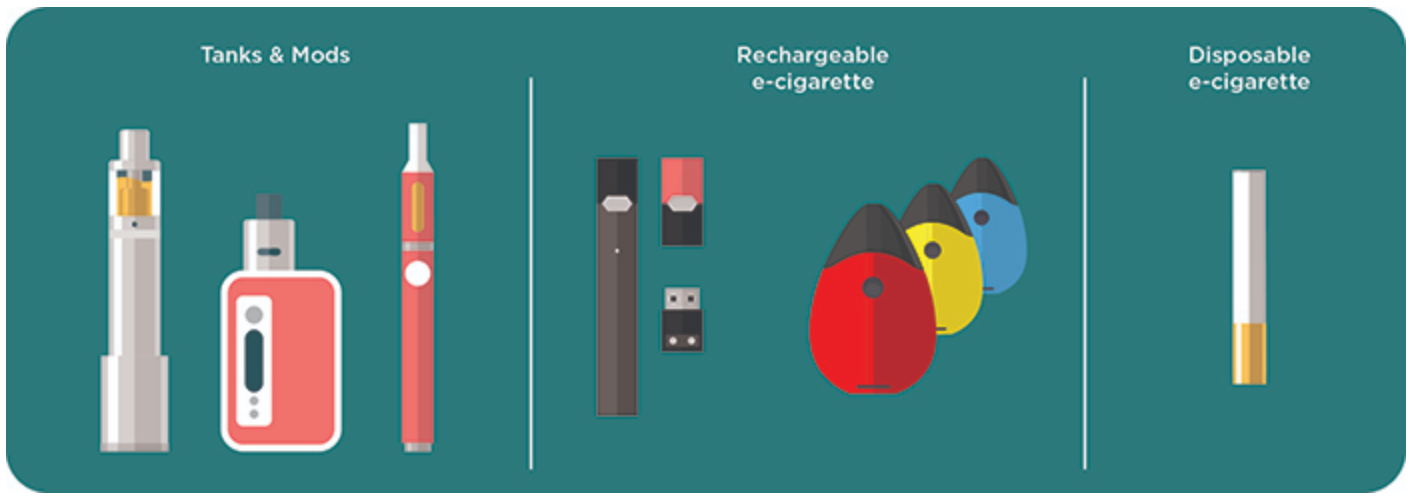Richmond, Va. - E-cigarettes coming in many shapes and sizes, and have gone by many different names. Some of those names include, “e-cigs,” “e-hookahs,” “mods,” “vape pens,” and “electronic nicotine delivery systems (ENDS)”.[1] E-cigarettes heat the fluid inside them into a vapor or aerosol. The fluid can contain nicotine, ultrafine particles, organic compounds, cancer-causing chemicals, heavy metals, and nearly anything else that can be broken down into a liquid.
One of the most important facts about vaping is that “It is difficult for consumers to know what e-cigarette products contain.”[2]
Current Use
In the United States, e-cigarette use has skyrocketed, especially in youth. According to the CDC, in 2018 more than 3.6 million middle and high school students had used e-cigarettes in the past 30 days. In 2017, 2.8% of US adults were current e-cigarette users.[3]
Vaping is a leading public health issue in the United States, with 805 people hospitalized so far this year, and the number of deaths climbing to 12.[4],[5] Many of those recently hospitalized for lung illnesses related to vaping have reported using products that include THC.
The issue has garnered national and political attention. Massachusetts banned the sale of all vaping products temporarily, Walmart has stopped selling all vaping products, and California allocated $20 million for an awareness campaign.[6],[7] In addition, Michigan, New York, and Rhode Island have recently banned flavored vaping products especially popular with young people, and the Illinois State’s Attorney’s Office filed a lawsuit accusing Juul of using deceptive marketing aimed at teens.[8]
Myths
- Vaping is not harmful to your health, unlike traditional smoking
E-cigarettes heat nicotine, flavoring, and other chemicals to create the vapor that is inhaled. While e-cigarettes may expose you to fewer chemicals than traditional cigarettes, they can still expose you to toxic chemicals that are bad for your health.[9] Bystanders can breathe in this aerosol as well as secondhand smoke.[10] The American Cancer Society has said that e-cigarettes, while not safe, are “likely to be significantly less harmful for adults than smoking regular cigarettes.”[11]
- E-cigarettes are not addictive
Since nicotine is the primary agent in regular cigarettes and e-cigarettes, both are highly addictive. E-cigarettes can cause similar symptoms to traditional cigarettes, including craving, withdrawal, and physical reactions including higher blood pressure and adrenaline, increased heart rate, and an increased chance of heart attack.[12]
- E-cigarettes can help smoking cessation
According to Johns Hopkins University, “Although they’ve been marketed as an aid to help you quit smoking, e-cigarettes have not received [FDA] approval as smoking cessation devices.”[13]
- All the effects of e-cigarette smoking are known
While many things about e-cigarettes are already known and have been studied, “scientists are still learning about the long-term health effects of e-cigarettes.”[14] It is known, however, that e-cigarettes containing nicotine are addictive, toxic to fetuses, and can harm brain development in adolescents.[15]
[1] CDC (n.d.). Electronic Cigarettes. What’s the Bottom line? Centers for Disease Control and Prevention. Retrieved from https://www.cdc.gov/tobacco/basic_information/e-cigarettes/pdfs/Electronic-Cigarettes-Infographic-p.pdf
[2] CDC (n.d.). About Electronic Cigarettes (E-Cigarettes). Centers for Disease Control and Prevention. Retrieved from https://www.cdc.gov/tobacco/basic_information/e-cigarettes/about-e-cigarettes.html
[3] CDC (n.d.). About Electronic Cigarettes (E-Cigarettes).
[4] Hamblin, J. (2019, October 1). The Actual Harms of Vaping. The Atlantic. Retrieved from https://www.theatlantic.com/health/archive/2019/10/how-dangerous-vaping/599209/
[5] CBS News. (2019, October 1). Juul withdraws support for ballot measure aimed at overturning anti-vaping law in San Francisco. CBS News. Retrieved from https://www.cbsnews.com/news/juul-withdraws-from-proposition-c-ballot-campaign-in-san-francisco-california-flavor-e-cigarette/
[6] Hamblin, J. (2019, October 1). The Actual Harms of Vaping. The Atlantic. Retrieved from https://www.theatlantic.com/health/archive/2019/10/how-dangerous-vaping/599209/
[7] Koran, M. (2019, September 16). California launches $20 million campaign to deter e-cigarettes amid spike in illnesses. The Guardian. Retrieved from https://www.theguardian.com/us-news/2019/sep/16/california-vaping-campaign-illnesses-ecigarettes
[8] CBS News
[9] CDC (n.d.). Electronic Cigarettes. What’s the Bottom line?
[10] CDC (n.d.). About Electronic Cigarettes (E-Cigarettes).
[11] CBS News.
[12] Blaha, M.J. (n.d.). 5 Vaping Facts You Need to Know. Johns Hopkins University. Retrieved from https://www.hopkinsmedicine.org/health/wellness-and-prevention/5-truths-you-need-to-know-about-vaping
[13] Blaha, M.J. (n.d.).
[14] CDC (n.d.). Electronic Cigarettes. What’s the Bottom line?
[15] CDC (n.d.). Electronic Cigarettes. What’s the Bottom line?

